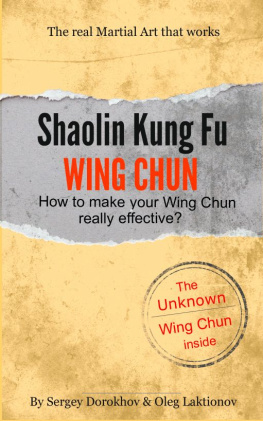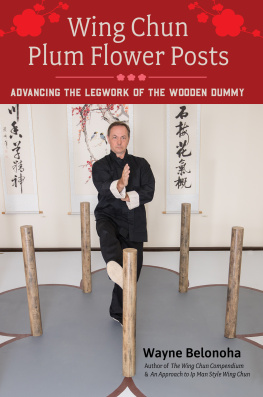Shaolin Kung Fu Wing Chun
Sergey Dorokhov and Oleg Laktionov
Smashwords Edition
Copyright 2013 Sergey Dorokhov, Oleg Laktionov
License Notes: This ebook is licensed for yourpersonal enjoyment only. This ebook may not be re-sold or givenaway to other people. If you would like to share this ebook withanother person, please purchase an additional copy for each personyou share it with. If youre reading this book and did not purchaseit, or it was not purchased for your use only, then you shouldreturn to Smashwords.com and purchase your own copy. Thank you forrespecting the hard work of this author.
Ebook formatting by www.ebooklaunch.com
Table ofContents

Please review our book. Thank you so much!
About the Authors
Oleg Laktionov and Sergey Dorokhov have morethan twenty years of experience and training in full-contact combatsports (boxing, sambo, sanda, ITF taekwondo). Ten years of thistime has been devoted to the study of Wing Chun developed in the IpMan tradition by Chow Tze Chuen. The founder of several schoolswith dedicated students, the authors, nevertheless, sought to addboth depth and breadth to their own understanding of Wing Chun.This quest took them to China, where fate led them to thegreat-grandson of Master Chan Wah Shun, himself a master of WingChun. It was their studies with the great-grandson of Chan Wah Shunthat revolutionized the authors' understanding of Wing Chun andgreatly impacted their practice.
Originating in southern China, Wing Chun istoday one of the most popular forms of Chinese martial arts in theworld with over five million practitioners. As a branch of kung fu,Wing Chun has evolved in many different directions under theinfluence of the many different masters who developed the diversestyles of Wing Chun that we see today. The best known of thesestyles are Ip Man Wing Chun, Gulao/Kulo Wing Chun, Jee Shin WingChun, Chan Hwa Shun Wing Chun, Malaysian Wing Chun, Pan Nam/PengNan Wing Chun, Vietnamese Wing Chun, and Yuen Kay San WingChun.
Although all these forms of Wing Chun have acommon origin and share basic principles and training methods, theynevertheless diverge in one way or another. Often, thesedifferences are significant. This is why practitioners andaficionados of Wing Chun often find themselves debating thequestion of which 'Wing Chun' is the most authentic.
Nowadays there is a proliferation of booksabout Wing Chun, and the bulk of these books adhere to the Ip Mantradition. Over half of the five million practitioners of Wing Chunnoted above fall into the Ip Man camp.
That this is so suggests that the Ip Manschool of Wing Chun represents the standard for Wing Chun, passeddown intact from generation to generation from master to student.Under this line of thought, all the other branches of Wing Chunsplintered off from the Ip Man schools, borrowing elements from itor altering the Ip Man technique and introducing new theoreticaland technical principles to the style. Or else these are regardedas completely separate martial styles in the Wing Chun "tradition".None of these interpretations reflect the true origin and historyof Wing Chun. As a system, Wing Chun as always been closed. It wasnot taught to just anyone who felt like studying it. Each master,as a rule, had no more than ten students. Ip Man, by the way, wasthe ninth and final student of Master Chan Wah Shun. Because ofthis secrecy, Wing Chun, as a style, was not well-known aroundChina. It is sad, but true that for the very same reason manyunique forms of Wushu fighting simply died out and disappeared. Thestyle attributed to Ip Man owes its global popularity primarily tothe legendary actor and martial arts master Bruce Lee. It isbecause of Bruce Lee that the Western world became aware of theexistence of Wing Chun. And after the death of Ip Man, many of hisnumerous students poured into America and Europe, where they openedup studios in which anyone who wished could study the Ip Man formof Wing Chun. And so today Wing Chun is very wide-spread andavailable. Under the auspices of various Wing Chun organizationsand associations schools have been established in virtually everydeveloped country around the world. And yet in China itself thereare masters who, to the present day, maintain and preserve the oldtraditions, and, despite all their generosity, these masters do notwillingly share the secrets of the style even to their compatriots,much less to foreign seekers of such knowledge. This, naturally,has inhibited the development of many truly interesting branches inthe Wing Chun system of martial arts. The book you are holding isnot intended as a comprehensive work on Wing Chun theory andtraining methods, nor is it even a full description of the style,itself. The aim of this book, in general terms, is to acquaint thereader with the branch of Wing Chun developed by Grandmaster ChanWah Shun, the teacher of Ip Man. This is the style which Ip Manbegan studying as a thirteen-year-old adolescent. Unfortunately,however, circumstances prevented him from completing even a thirdof the studies involved in the training.
But this is in no way intended as adenigration of the contribution made by Ip Man as a master of WingChun, nor of his style, which is an effective martial arts fightingsystem when engaged in by the practitioner with the right knowledgeand skills. Our aim is to provide you with information that ispertinent to your own practice and speaks to your interests in WingChun in a profitable way. In subsequent books we will expound ingreater detail on the various aspects of Wing Chun trainingdeveloped by Grandmaster Chan Wah Shun.
Writing about the history of the Wing Chunstyle is very interesting and at the same time not that simple, asthere is no reliable information about where the style originated,or of those who stood at its source, or the exact date of itsorigin. There are so many different legends and so manyinterpretations. This is the case for most styles of Chinese Wushu,not just Wing Chun. Only a few of the known existing styles have arecorded history. The reason for this may lie in the fact that manyof the old masters were illiterate, and so the history of eachstyle was often passed on orally from generation to generation,gathering details and episodes that never existed before, with agood dose of mysticism thrown in and therefore strongly varyingfrom storyteller to storyteller. After a while these stories werebeginning to look more like fairy tales.
Even today, the creators of many styles ofWushu often referred to as Grand masters, the existence of whom isnot supported by any documentary evidence so they may have beenmythological characters or perhaps characters from the traditionalChinese epics. But there is also the fact that the real stories ofmany styles of martial arts were kept secret, a great secret, andpassed only to a select few. What was the reason? The reasonexists, and is explained by, the close links of the Wushu schoolswith Chinese mystical tradition. When a student knows the trueorigins of their school, it gives him the opportunity to find somekind of mystical connection with the founding masters of the style,to join their spirit, to feel a link in the chain of transmissionand reception of higher knowledge of past generations togenerations of future martial artists, and thus become therecipient of the spiritual traditions of the school. Therefore, forthe Chinese, the history of the style is not the conventionalquestion of asking in what order the events took place, but toidentify the ways in which the true tradition of the secretknowledge of the school was passed on.











